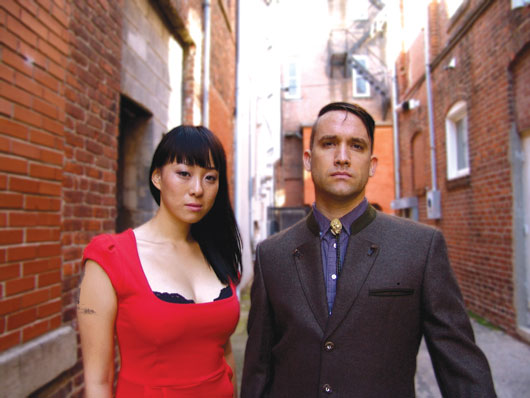Artist Tips: Xiu Xiu
Jamie Stewart, the mastermind behind veteran indie band Xiu Xiu, has been using wonky electronics […]

Jamie Stewart, the mastermind behind veteran indie band Xiu Xiu, has been using wonky electronics to create his sinisterly playful and completely abrasive sounds since his first album, 2002’s Knife Play. Moving deeper into the 21st century, Stewart continues to employ new approaches in creating the electronic elements that color his fractured pop tunes, including the Korg DS-10 software for the Nintendo DS, modeled after Korg’s classic MS-10 synth. Here Stewart gives us the lowdown on the DS-10’s moving parts, and explains how Xiu Xiu’s touchpad compositions came to life on Dear God, I Hate Myself, the band’s newest record for Kill Rock Stars.
1. Drum machine
On the DS-10, there are four drum sounds and four drum tracks, which can be step-written or tap-written with four little “pads” on the screen. The step-writing has the wonderful feature of being divided into seven octaves, so your kick sound can go anywhere from sub-bass to tiny clicks. As well, you can use a virtual knob style interface to create analog drum sounds from scratch. Never having had the money for a real analog drum machine, this opened my ears to that world in a new way. The Congotronics style melodic bass drum on “Apple for a Brain” was a product of this interface.
2. Synths
There are two mono synths and two sequencers. Like the drum machine, the synths can be step-written or played on a touchscreen keyboard, and also have seven octaves. The touchscreen is a little tough to play because it is so small, but it is useful to work out parts or try harmonies with a previously programmed line. You can program the sounds for both synths in the same way as the drums, with virtual knob controllers over all the basic parameters. There is also, like the Korg, a patch-bay screen to manipulate pitch and the filter against square, saw, and triangle waves.
3. Sequencer
On the song “Secret Motel,” which I wrote on trains during a European tour using only the DS-10, I used the sequencers for incredibly fast and intertwining lines going bonkers all up and down multiple octaves with zimzam death-cute sounds.
4. Effects
You can apply chorus, flanger, and a good-sounding delay to each drum sound individually, further enhancing your creativity. (It makes for fantastic Martin Hannett-style permutations.) On Roland drum boxes I have used, you couldn’t put individual effects on a single drum sound. For “Dear God, I Hate Myself,” being able to do this made the drums, which are the main part of the song, feel much more freaked out and odd. These are not as incredible as the programming, but they can add a finishing touch to a sound.
5. Kaoss Pad
The two Kaoss Pads are touchscreens that can, depending upon where you place the stylus on an X/Y axis, control two different parameters of a sound. You can sweep across the screen and turn up the distortion while turning up the release on the EG filter. You can then record this move in real time in the sequencer. The “knobs” will then continue to change the sound as you played it with the beat.

